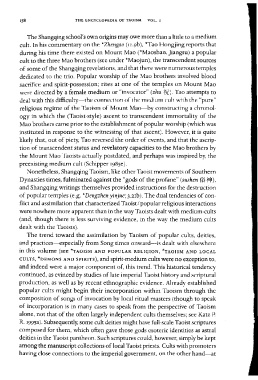Page 198 - The Encyclopedia of Taoism v1_A-L
P. 198
THE ENCYCLOPEDIA OF TAOISM VOL. I
The Shangqing school's own origins may owe more than a little to a medium
cult. In his commentary on the *Zhengao (II.9b), *Tao Hongjing reports that
during his time there existed on Mount Mao (*Maoshan, Jiangsu) a popular
cult to the three Mao brothers (see under *Maojun), the transcendent sources
of some of the Shangqing revelations, and that there were numerous temples
dedicated to the trio. Popular worship of the Mao brothers involved blood
sacrifice and spirit-possession; rites at one of the temples on Mount Mao
were directed by a female medium or "invocator" (zhu fJi). Tao attempts to
deal with this difficulty-the connection of the medium cult with the "pure"
religious regime of the Taoism of Mount Mao-by constructing a chronol-
ogy in which the (Taoist-style) ascent to transcendent immortality of the
Mao brothers came prior to the establishment of popular worship (which was
instituted in response to the witnessing of that ascent). However, it is quite
likely that, out of piety, Tao reversed the order of events, and that the ascrip-
tion of transcendent status and revelatory capacities to the Mao brothers by
the Mount Mao Taoists actually postdated, and perhaps was inspired by, the
preexisting medium cult (Schipper 198se).
Nonetheless, Shangqing Taoism, like other Taoist movements of Southern
Dynasties times, fulminated against the "gods of the profane" (sushen 1ti fEll),
and Shangqing writings themselves provided instructions for the destruction
of popular temples (e.g. *Dengzhen yinjue; 3.2Ib). The dual tendencies of con-
flict and assimilation that characterized Taoist / popular religious interactions
were nowhere more apparent than in the way Taoists dealt with medium-cults
(and, though there is less surviving evidence, in the way the medium cults
dealt with the Taoists).
The trend toward the assimilation by Taoism of popular cults, deities,
and practices-especially from Song times onward-is dealt with elsewhere
in this volume (see *TAOISM AND POPULAR RELIGION, *TAOISM AND LOCAL
CULTS, *DEMONS AND SPIRITS), and spirit-medium cults were no exception to,
and indeed were a major component of, this trend. This historical tendency
continued, as evinced by studies of late imperial Taoist history and scriptural
production, as well as by recent ethnographic evidence. Already established
popular cults might begin their incorporation within Taoism through the
composition of songs of invocation by local ritual masters (though to speak
of incorporation is in many cases to speak from the perspective of Taoism
alone, not that of the often largely independent cults themselves; see Katz P.
R. 1995a). Subsequently, some cult deities might have full-scale Taoist scriptures
composed for them, which often gave those gods esoteric identities as astral
deities in the Taoist pantheon. Such scriptures could, however, simply be kept
among the manuscript collections of local Taoist priests. Cults with promoters
having close connections to the imperial government, on the other hand-at

